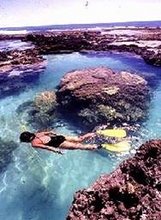
Abstract of paper presented by Chen to the IUCN-World Commission on Protected Area Third Southeast Asia Regional Meeting, April 2003
Giant clams are bivalves that had been declared endangered by the Convention on the International Trade of Endangered Species (CITES) of flora and fauna. Seven out of nine species are found in the Philippines. Out of the seven species, the Tridacna gigas is being cultures by the University of the Philippines Marine Science Institute (UP-MSI). The Marine Ecosystem Council, Inc. (MEC) has partnered with UP-MSI and had been deploying cultured Tridacna gigas since 1996 in marine protected areas of the Philippines. MEC has established various project components including site selection, site evaluation, clam collection, training, seeding, IEC, monitoring and laternative livelihood through community-based sustainable tourism in MPA. MEC has also developed seeding techniques that promote diver safety and ensures higher survival rate of the seeded clams. Monitoring activities show that when partner-communities protect clams until they reach sexual maturity, it hastens recovery of over-fished areas. In MEC seeding sites, there was an observed increase in fish density and biodiversity. Clam seeding is an activity that aims to save endangered species from extinction consequently enhance the ecology of marine protected areas, bringing about direct and indirect benefits to stakeholders. In the long run, these benefits also translate to food security for people living in the coastal areas.
Giant clams are bivalves that had been declared endangered by the Convention on the International Trade of Endangered Species (CITES) of flora and fauna. Seven out of nine species are found in the Philippines. Out of the seven species, the Tridacna gigas is being cultures by the University of the Philippines Marine Science Institute (UP-MSI). The Marine Ecosystem Council, Inc. (MEC) has partnered with UP-MSI and had been deploying cultured Tridacna gigas since 1996 in marine protected areas of the Philippines. MEC has established various project components including site selection, site evaluation, clam collection, training, seeding, IEC, monitoring and laternative livelihood through community-based sustainable tourism in MPA. MEC has also developed seeding techniques that promote diver safety and ensures higher survival rate of the seeded clams. Monitoring activities show that when partner-communities protect clams until they reach sexual maturity, it hastens recovery of over-fished areas. In MEC seeding sites, there was an observed increase in fish density and biodiversity. Clam seeding is an activity that aims to save endangered species from extinction consequently enhance the ecology of marine protected areas, bringing about direct and indirect benefits to stakeholders. In the long run, these benefits also translate to food security for people living in the coastal areas.









No comments:
Post a Comment